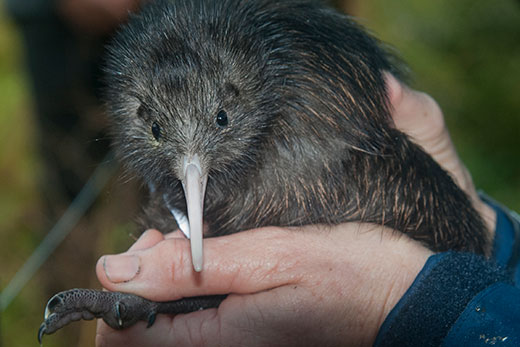Prime Minister John Key has announced the Government is working towards the goal of making New Zealand predator free by 2050.
The Government will be investing an initial $28 million into a new joint venture company called Predator Free New Zealand Limited to drive the programme alongside the private sector.
The Government has announced it has adopted the goal of New Zealand being predator free by 2050. Photo: File
This funding is on top of the $60m to $80m already invested in pest control by the government every year and the millions more contributed by local government and the private sector.
Predator Free NZ Ltd. will be responsible for identifying large, high value predator control projects and attracting co-investors to boost their scale and success.
'Rats, possums and stoats kill 25 million of our native birds every year, and prey on other native species such as lizards and, along with the rest of our environment,” the PM says.
'We must do more to protect them.”
John says these introduced pests also threaten the economy and primary sector, with their total economic cost estimated at around $3.3 billion a year.
The Government will look to provide funding on a one for two basis - that is for every $2 local councils and the private sector put in, the Government will contribute another dollar.
Conservation Minister Maggie Barry says achieving the goal of a Predator Free New Zealand by 2050 will require a massive team effort across the public, private, iwi and community sectors.
Under the strategy Predator Free NZ Ltd. will sponsor community partnerships and pest eradication efforts around the country.
'By bringing together central and local government, iwi, philanthropists, and community groups, we know that we can tackle large-scale predator free projects in regions around New Zealand,” says Maggie.
'Project Taranaki Mounga and Cape to City in Hawke's Bay are great examples of what's possible when people join forces to work towards a goal not achievable by any individual alone.”
The Predator Free 2050 Project will combine the resources of the Department of Conservation and the Ministry for Primary Industries to work in partnership with local communities.
Primary Industries Minister Nathan Guy says the goal of a Predator Free New Zealand by 2050 will have major positive impacts for farmers and the wider primary sector.
'Possums and ferrets are the main carriers of bovine TB, which is a very destructive disease for cattle and deer. In this year's Budget the Government committed $100 million towards combined eradication efforts with industry starting with cattle and deer by 2026,” says Nathan.
'By pooling our resources and working together we can jointly achieve our goals of both eradicating bovine TB, and achieving a predator free New Zealand.”
Not all the technology to make New Zealand predator free yet exists, and the Biological Heritage National Science Challenge will have an important role in developing the science to achieve the predator free goal.
Science and Innovation Minister Steven Joyce says with New Zealand a world leader in conservation technology and research, the Biological Heritage Challenge has an established network of scientists who are ready and willing to take on the Predator Free Challenge.
'For the first time technology is starting to make feasible what previously seemed like an unattainable dream.”
PREDATOR FREE NEW ZEALAND LIMITED: THE WHO AND THE WHAT
Predator Free New Zealand Limited will have a board of directors made up of government, private sector, and scientific players.
The board's job will be to work on each regional project with iwi and community conservation groups and attract $2 of private sector and local government funding for every $1 of government funding.
The four goals for 2025 set for the project atre:
- An additional 1 million hectares of land where pests have been supressed or removed through Predator Free New Zealand partnerships
- Development of a scientific breakthrough capable of removing at least one small mammalian predator from New Zealand entirely
- Demonstrate areas of more than 20,000 hectares can be predator free without the use of fences
- Complete removal of all introduced predators from offshore island nature reserves

'New Zealand's unique native creatures and plants are central to our national identity. They evolved for millions of years in a world without mammals and as a result are extremely vulnerable to introduced predators, which kill around 25 million native birds every year,” says Conservation Minister Maggie Barry.



6 comments
Councils
Posted on 25-07-2016 16:52 | By Crash test dummies
Does that mean that we can go exterminate ... exterminate them now?
@ John Key
Posted on 25-07-2016 16:53 | By Captain Sensible
Does that include the likes of the killers of innocent children?
Great but
Posted on 25-07-2016 18:40 | By overit
Good news but does that mean the country will be doused in 1080? Dissoving in the rivers etc.
Whilst I
Posted on 25-07-2016 19:20 | By Merlin
Whilst I support this proposal I doubt if the rats will be exterminated.I live in a rural area close to a bush area and I can not see how rats can all be exterminated in New Zealand everywhere.
Directors fees?
Posted on 26-07-2016 09:25 | By Darren
Predator Free New Zealand Limited will have a board of directors made up of government, private sector, and scientific players. Could be a cushy number for Key's mates.
Hmmmm
Posted on 26-07-2016 09:57 | By How about this view!
Is this a step towards reducing our unemployment numbers as well? If so, what a great idea. Getting the lazy and feckless amongst us, out of the house and becoming productive members of society. If you can't find a job we'll give you one, just bring in the tails or ears.
Leave a Comment
You must be logged in to make a comment.